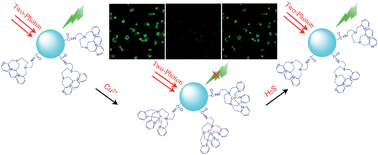A two-photon “turn-on” fluorescent probe based on carbon nanodots for imaging and selective biosensing of hydrogen sulfide in live cells and tissues†
Abstract
Determination of hydrogen sulfide (H2S) in live cells and tissues is still a challenge for evaluating the key roles that H2S plays in physiological and pathological processes. In this work, a “turn-on” two-photon fluorescent (TPF) sensor for H2S is developed, in which carbon nanodot (C-Dot) was employed as a two-photon fluorophore due to its large two-photon absorption cross-section (σ), and AE-TPEA–Cu2+ complex [AE-TPEA = N-(2-aminoethyl)-N,N,N′-tris(pyridin-2-ylmethyl)ethane-1,2-diamine] was first designed as a specific receptor for H2S. The fluorescence of C-Dot conjugated with AE-TPEA (C-Dot-TPEA) was quenched upon the addition of Cu2+. Then, the fluorescence was restored after the addition of H2S, because Cu2+ could be released from TPEA binding site when H2S interacted with the Cu2+ ion. The designed C-Dot-TPEA–Cu2+ fluorescent sensor exhibited high specificity for H2S over biothiols, sulfur-containing compounds, reactive oxygen species (ROS), and other biological interferences. Meanwhile, a broad linear range from 5 μM to 100 μM was obtained and the detection limit was achieved to 0.7 μM. In addition, the C-Dot-based TPF probe exhibited bright two-photon fluorescence, favourable photostability against light illumination and pH change, and low cytotoxicity. Accordingly, the nanohybridized TPF sensor with high selectivity and sensitivity, as well as the fascinating properties of C-Dot themselves, successfully provided a new way for TPF imaging and biosensing of H2S in live cells and tissues. We believe this is the first report of TPF imaging and biosensing of H2S in live cells and tissues using a specially engineered C-Dot-based nanosystem.


 Please wait while we load your content...
Please wait while we load your content...